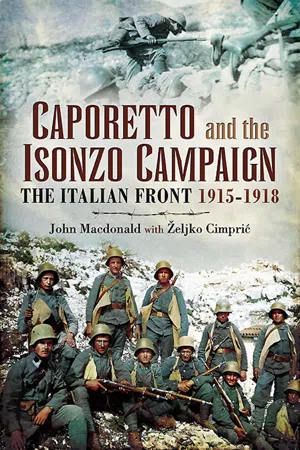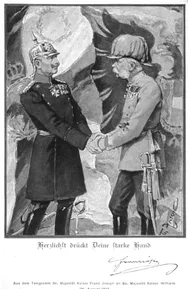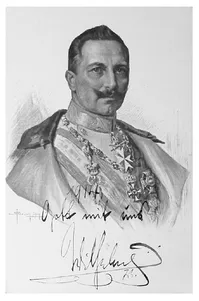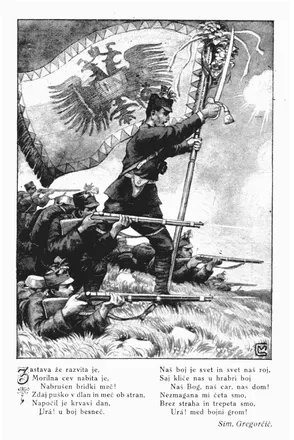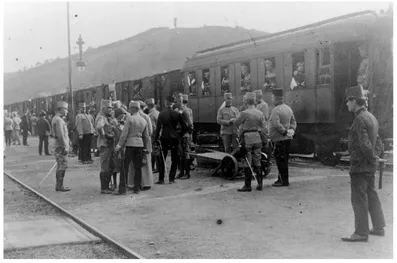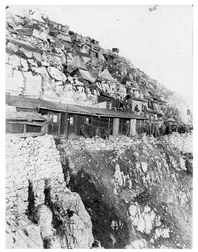![]()
Chapter 1
Background to the Campaign
If any question why we died,
Tell them, because our fathers lied.
Rudyard Kipling, Epitaphs of the War (1919)
Italy stepped into the First World War on 23 May 1915, when she declared war on her erstwhile ally, the Austro-Hungarian Empire. To understand the reasons behind Italy’s delayed entry into the war, and the attitudes of both sides to the conflict, it is sensible to consider the causes of the war in a wider context.
Map of the period showing the Habsburg (Austro-Hungarian) Empire.
The inexorable descent into conflict between the competing powers of Europe began with the formation of the German Empire in 1871, following the defeat of France by Prussia in 1870. Bismarck, the first Chancellor of the German Empire, then secured Germany’s position by establishing the Central Powers with the conclusion of the Triple Alliance between Germany, Austria and Italy. The motivation for Italy to join the Alliance derived from her long-standing fear of France, resulting from historic border disputes that are beyond the scope of this book, but she wisely negotiated an opt-out from the treaty if the Alliance went to war with the United Kingdom, with whom she had important trade relations. Bismarck also opened negotiations for a diplomatic accord with Russia.
Friends and allies. A postcard sold in Vienna in August 1914 purporting to show the close working relationship between the Habsburg Kaiser Franz Joseph and the German Kaiser. In truth the German emperor and his generals had little respect for the Austro-Hungarians, as soldiers or as a nation.
The accession of the young and ambitious Kaiser Wilhelm II accelerated the process of German expansion. He was determined to direct policy himself and to enhance the status of Germany as a world power. He brought about Bismarck’s resignation but failed to continue the nego-tiations with Russia. He then began to challenge Britain’s long-established mastery of the seas with a massive naval building programme. This alarmed Germany’s neighbours, who began a series of diplomatic moves for their collective protection. In 1894 France took advantage of the Kaiser’s failure to reach an agreement with Russia and entered into the Dual Alliance with the Russians. In 1902 Britain formed an alliance with Japan and in 1904 signed the Entente Cordial with France; after the end of hostilities between Russia and Japan, this became a triple alliance between Britain, France and Russia. Now Germany began to fear encirclement. General von Schlieffen, the retired German chief of the general staff, warned about the ‘danger of Britain, France, Russia and even Italy . . . preparing for a concerted attack on the Central Powers’. So the tension mounted, driven by a lethal mixture of ambition and fear.
Austro-Hungary and the Balkans
Throughout this period the Habsburg Empire was in decline, its largely agrarian economy struggling to compete with the rapidly industrialising nations of western Europe. It also faced potential enemies from both within and without. There had always been tension between the Austrians and the Magyars of Hungary, but now this was aggravated as the other polyglot peoples of the empire sought to establish their national identities. The rise of nationalism was most evident in the volatile Balkan states.
A signed photograph of an imperious Kaiser Wilhelm.
The concept of a Yugoslavian independent state was gaining ground in the northern Balkan states, with the Serbs generally taking the lead. Austria, in an attempt to impose her authority on the area, seized the opportunity to annex Bosnia in 1908, when its Muslim supporter Turkey was distracted by her own internal problems. Serbia saw this as a threat and appealed to Russia, a fellow Slav nation, for support. This in turn alarmed other European powers and the Bosnian situation escalated into an international crisis. The Germans were furious at the Austrians’ inept handling of the situation and persuaded them to pay compensation to the Turks, but from then on remained wary of their unreliable ally. The crisis was over but below the surface the tension remained. The Balkans provided the tinderbox, and the fuse was lit in Sarajevo in June 1914.
Italy and Italia Irrendenta
Like Germany, Italy was a new nation but she was not a great power. The Kingdom of Italy was formed in 1860 but was not fully united as a nation until 1870, when the kingdom displaced the Pope as the ruler of Rome. Henceforth, the battle between Church and state was to be a long-term source of division in the new nation. Much of Italy was economically backward, its rural peasant population crippled by poverty and illiteracy, but in the industrialising north there was a growing sense of national pride. The revolutionary zeal that created Italy also spawned the Italia Irrendenta (‘unredeemed Italy’) movement which demanded the return to Italy of those territories still under Austrian rule that had a large Italian-speaking population. These territories were mainly centred in the north in the Trentino and in the border areas of the east, including the Adriatic port of Trieste. The Triple Alliance made any such ambitions an impossible objective at the time, so instead Italy turned her attention, with mixed success, to gaining some colonial territories. This brought her into conflict with France and strengthened her allegiance to the Triple Alliance. However, the Italians were reluctant to be drawn into the conflict in 1914, despite the wishes of their Prime Minister Antonio Salandra. Apart from some initial patriotic enthusiasm in the north, there was no strong popular support for the war throughout the long years of the violent battles on her borders.
Slovenian propaganda postcard of a patriotic poem by Simon Gregorcic.
Seducing the neutrals
When the First World War broke out Italy and many other states remained neutral; with an eye to their own interests, they watched events closely and tried to determine who was winning, and whether possible participation would be to their advantage. The Central and the Entente Powers were each using every device possible to seduce or blackmail the neutral nations on to their side. At the outset Germany sought Italy’s early entry into the war on her side, offended that her Alliance associate had not yet joined the war and anxious to relieve the pressure on the Western Front. However, much to the chagrin of the Germans, the Austrians found Italian demands for the return of their territory unacceptable. The French, meanwhile, concerned about their flank, tried to foment pro-war attitudes among Italian politicians, and even financed a newspaper on behalf of Benito Mussolini. The future Fascist leader had deserted the socialists because of their reluctance to intervene in the war, and vigorously preached in favour of the war in support of the Italia Irrendenta movement.
Slovene soldiers entraining at Maribor station for the Russian Front.
The French and the British then entered into detailed secret negotiations with the Italians to determine the price for their entry into the war on the side of the Entente. Naturally the Entente partners had little difficulty in acceding to all of Italy’s demands for Austro-Hungarian territory, which included stretches of the eastern Adriatic coast. Finally, on 28 April 1915, Britain, France and Italy signed the secret Treaty of London that guaranteed the return of Italian territories and committed the Italians to a ‘speedy offensive’ against the Austro-Hungarian Empire.
![]()
Chapter 2
The Appalling Terrain
‘The Carso is probably the strongest natural fortress in the world.
Anything in the shape of defensive works which Nature had
overlooked, the Austrians provided.’
E. Alexander Powell, American journalist, 1916
On 23 May 1915 Italy declared war on the Habsburg Empire and opened a 375-mile front on its northern and eastern borders with the Empire. Although there would be continuous fighting on the northern front, including repeated Austrian offensives on the Trentino, the main focus of the Italians was on the Isonzo Front. This, at the time, seemed to promise opportunities both to realise the claims of the Italia Irrendenta and to pave the way for a victorious march on Budapest or Vienna across the central plain of Slovenia.
Italian tents and barracks above the mountain wall on Mt Batognica (in Italian, Mt Rosso); they were 500 feet from the enemy for twenty-eight months.
The Isonzo Front stretched from Mt Rombon in the north along some 60 miles either side of the Isonzo to the Adriatic Sea in the south. In terms of the terrain, this front can be divided into three distinct areas:
- • The northern area of the Julian Alps dominated by Mt Rombon, 6,757 feet, to the north above Bovec and Mt Krn, 7,410 feet, on the west bank of the Isonzo above Caporetto.
- • The central plateau area characterised by the multiple plateaux of the Bainsizza.
- • The southern Carso Plateau that extended down to Trieste on the Adriatic.
Mt Batognica: the first line was some 6000 feet above the Isonzo, and Kolovrat on the far bank. Trieste bay is on the horizon (left) and Cividale and Friuli on the right.
Each of those areas presented a particular challenge to the military planners and the soldiers involved in executing their plans. Today the valley of the Soca (the Slovenian name for the Isonzo) is one of the most beautiful valleys in Europe and has become an international playground for mountain and water sports in both summer and winter. This causes difficulties for the modern military historian. To fully comprehend the conditions facing the armies of 1915 it is necessary to understand the differences in the same terrain between 1915 and today. Nature and man have combined to make dramatic changes over that time.
The mountains of the Jul...
